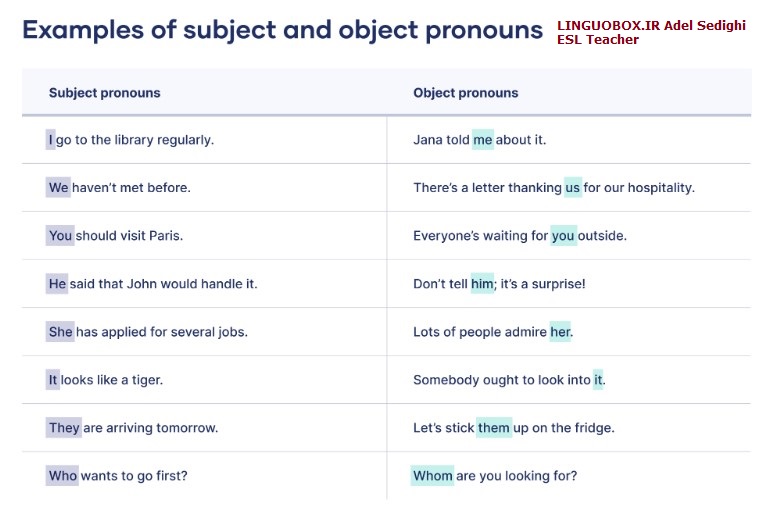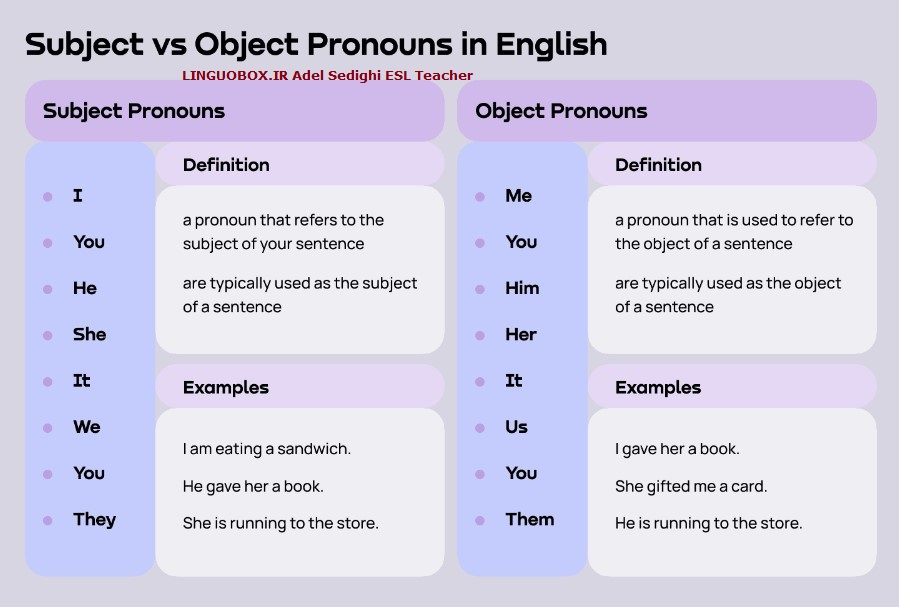ضمایر فاعلی ضمایر مفعولی


Subject & Object Pronouns | Definition & Examples
Subject and object pronouns are two different kinds of pronouns (words that replace nouns) that play different grammatical roles in sentences:
- A subject pronoun (I, we, he, she, they, or who) refers to the person or thing that performs an action. It normally appears at the start of a sentence, before the verb.
- An object pronoun (me, us, him, her, them, or whom) refers to the person or thing affected by an action. It normally comes after a verb or preposition.
Subject pronouns
A subject pronoun (sometimes called a nominative pronoun) functions as the subject of a verb. That means that it represents the person/people or thing(s) that perform the action described. Because of this, it normally appears at the start of the sentence, followed by a verb.
They are stacked in a pile under the desk.
Who took my umbrella?
In more complex sentence structures, a subject pronoun may appear in other positions—in the middle of a sentence, after the verb, or separated from the verb. For example, it may form part of a relative clause or a question, or some other words may come between it and the verb.
He always goes out for drinks on Friday night.
Did we ever visit Egypt before?
She and I, despite our differences, have a surprisingly good relationship.
Object pronouns
An object pronoun (sometimes called an objective pronoun) functions as the object of a verb or preposition. That means that it represents the person/people or thing(s) affected by an action. An object pronoun normally appears after a verb (e.g., “tell”) or preposition (e.g., “to”).
They wouldn’t let us come inside.
Take it from me: just talk to her about it.
To me, it seems simple enough.
The object pronoun isn’t always right next to the verb or preposition it relates to. Separation commonly occurs with whom when it’s used as a relative pronoun or an interrogative pronoun. Some style guides recommend keeping the preposition and the pronoun together when possible, but it’s not mandatory.
He was the last person whom I expected to see.
Whom should we call in case of an emergency?
- You and me went to the beach. [“me went”] (incorrect)
- You and I went to the beach. [“I went”] (correct)
- If you have any questions, just ask Jeremy or I. [“just ask I”]
- If you have any questions, just ask me or Jeremy. [“just ask me”]
- A dog came running up to the kids and I. [“running up to I”]
- A dog came running up to the kids and me. [“running up to me”]
Combining a subject and object pronoun (e.g., “her and she,” “I and him,” “they or us”) is always wrong.
